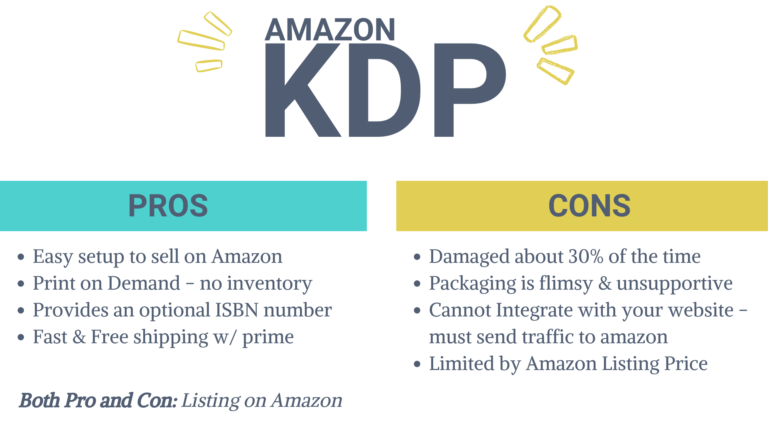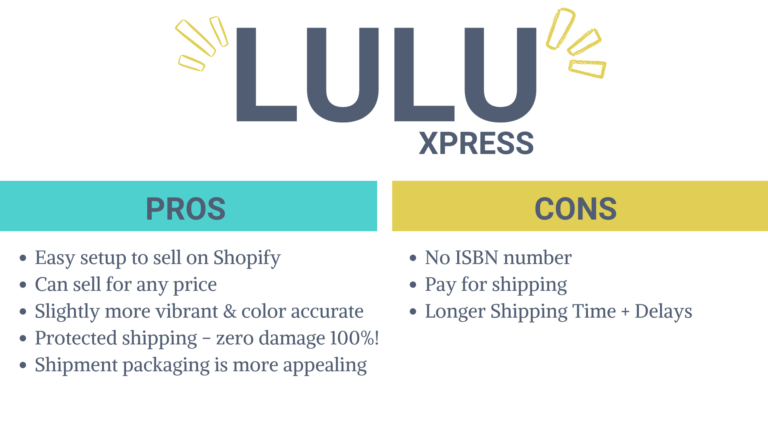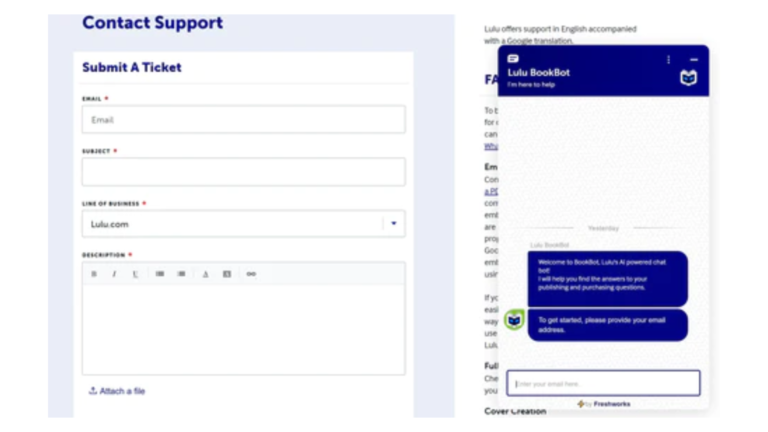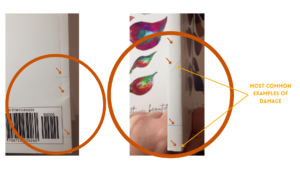In today’s video and article, I’ll provide an overview of Amazon KDP (Kindle Direct Publishing) and Lulu Xpress Direct App including how they compare so you can decide which one is right for you.
Before we dive right in, full disclosure – I’ve used both KDP and the Lulu Xpress Direct App to publish journals. Also, I built a Shopify website that integrates with the LuLu Xpress Direct App, which is comparable to KDP as a print on demand service and for publishing books, planners and journals.
Also, for clarification, throughout this post I’ll be referring to the Lulu Xpress Direct App (now known as The Lulu Direct App) AND to Lulu.com. These are two separate publishing services; the app integrates with Shopify to provide “print on demand” services and Lulu.com is the main publishing service that connects to Lulu’s bookstore and to their network of distributors.
Subscribe
Click to watch the full video or scroll down to read the full article. Additional videos and resources are linked at the bottom of the page.
HOW ARE KDP AND THE LULU XPRESS APP SIMILAR?
Before we take a closer look at the pros and cons of both KDP and the Lulu Xpress App, let’s start by addressing the benefits they both provide:

Print on Demand – KDP allows you to publish your journal, book or planner without having to commit to an inventory. KDP will print your journal, book or planner when an order is placed and will ship it directly to the customer. This saves time, money and resources.
Print Cost & Profit – The printing costs and the percentage of profit are comparable – Lulu does come out slightly ahead. Having said that, using the selling platform that is more effective for YOU (Amazon or Shopify, for example) is going to have a greater impact on your overall profit.
Binding, Covers & Pages – Both provide standard options, except that Lulu also provides Spiral binding. Both provide Paperback, Hard cover, Glossy and Matte options. Both provide the same page types, sizes and qualities.
Publishing Made Easy – It is easy to publish your journal, book or planner through KDP as well as LuLu. The processes have differences, but both are fairly straight forward.
THE PROS AND CONS OF SELF-PUBLISHING WITH AMAZON KDP
Before we take a look at Lulu, let’s explore an overview of KDP’s clear advantages:

THE BENEFITS
Print on Demand – as mentioned before, books, journals and planners are printed when the customer places an order. A major advantage to this is that you will have no inventory to manage or ship. It is also arguably better for the environment in that it cuts down on excess waste and additional transportation of your inventory. It also allows you to reduce upfront costs, and if you are starting a new business this can be a game changer.
Provides an ISBN Number – there is no extra cost for this and is a convenient and efficient way to apply a barcode and ISBN number.
Fast and Free Shipping – shipping is easy, free and quick for Amazon Prime members.
Easy Setup – Once your journal, book, or planner is approved by Amazon they will automatically create a listing for your product based off of the information you provided during the creation & publishing process.
THE DOWNSIDE
KDP does not integrate with your website – amazon wants to drive traffic to their site, not yours, so they will not allow you to integrate their KDP services with your website. However, you can link to your KDP listing from your website (if you have one) – to learn more check out this youtube video that covers selling KDP books, planners and journals with, or without, a website –> How to Sell Online Without a Website.
Regulated Pricing – Amazon wants to ensure that they have competitive pricing, so you will have to ensure that the price of your book, journal or planner is the same or lower on Amazon than it is on any other platform, including your own website. KDP also provides a pricing calculator that sets the minimum price required for your product.
Damaged Products – Because of the packaging that Amazon uses to ship your book, journal or planner it is likely that your product will be damaged along the way. There were also streaks of color and faded images and words printed across the cover at times as well, which likely occurred during the printing process.
KDP Cover Quality – Although the covers KDP produces are generally of high quality, they are less vibrant and color accurate than Lulu’s covers. The differences may not be noticeable to the general public, but if you designed your own covers it may make a difference to you.
For more current examples of packaging, cover quality and examples of damage – check out the video shown below KDP vs Lulu vs Printify | Journal Unboxing.
Current examples of packaging, common damage and cover quality in this video –> KDP vs Lulu vs Printify | Journal Unboxing
THE PROS AND CONS OF SELF-PUBLISHING WITH THE LULU XPRESS APP
Now that we have a clearer idea of what KDP provides, let’s take a look at Lulu:

THE BENEFITS
Print on Demand– as mentioned before, books, journals and planners are printed when the customer places an order. A major advantage to this is that you will have no inventory to manage or ship. It is arguably better for the environment in that it cuts down on excess waste and additional transportation of your inventory. It also allows you to reduce upfront costs, and if you are starting a new business this can be a game changer.
Shopify Integration – Lulu has partnered with Shopify to provide a seamless shopping, purchasing, fulfillment and shipping process for your print on demand journals, books and planners. It is relatively easy to connect the Lulu Xpress Direct App to your Shopify store, which allows you to publish, sell, print and ship your product smoothly.
Less Pricing Restrictions – Lulu does have a minimum pricing requirement (the cost to print the book + their profit), but they don’t have the same restriction KDP does when it comes to competitive pricing. This allows you more freedom in how your product is priced and if it is sold at different prices on other platforms and stores. However, there does appear to be a pricing “ceiling” for publishing certain products on Lulu.com, like E-books.
Shipping Packaging is Sturdy – Lulu ensures that your product will arrive in good condition and that it looks professional upon delivery. This ensures that your customer will be able to enjoy their purchase and won’t have to go through the hassle of returning their item.
Covers are Vibrant – Lulu’s printing process results in higher quality covers that are slightly more color accurate and more vibrant. Also, printing errors have not been an issue either – not one journal printed by Lulu has resulted in a bad review from a customer.
THE DOWNSIDE
No ISBN Number – because the Lulu Xpress Direct App does not require an ISBN number for “print on demand” sales of your book, the app does not generate an ISBN number. However, Lulu.com will provide a free ISBN number when publishing on their website.
Shipping Costs – As you may have guessed, Lulu does not provide free shipping. This means the customer will have to cover the costs of shipping or you may have to get creative by incorporating shipping costs into the product pricing so that you can advertise shipping as “free.”
Shipping Times & Delays – Most of the time, Amazon has a system of delivery and transportation teams ready to go – not just within the US, but internationally, too. The majority of other companies, like Lulu, rely on transportation chains such as USPS to handle delivery. While this is common – especially for small businesses – it is definitely a disadvantage when comparing Lulu with KDP. Having said that, all transportation based companies, including Amazon, USPS, Fed-ex, DHL and UPS can all be impacted by local and national challenges, such as employee shortages, COVID, Holiday and weather related delays.
CONCLUSION
Overall, I prefer to use Lulu – I like the hassle free purchasing, fulfillment and shipping process. I also like that I don’t have to worry about products arriving damaged or of a lower quality than what was advertised. And finally, if I am advertising my products, I would prefer to drive traffic to my website than to a marketplace, such as Amazon, where my potential customer could be easily distracted by the constant competition. Also, if a percentage of my journals are shipped to my customers with poor quality covers or interiors, that could result in poor reviews – which could make my effort to attract and retain customers a waste of time and money.
Having said that, KDP is at a minimum is an option worth serious consideration, especially if you expect to have customers who only purchase through Amazon for the free shipping. Additionally, Amazon KDP provides significant advantages that might apply to you – ie, if you have international customers (potential shipping advantage) and if you do not want to create and maintain your own website. And when it comes to managing sales tax, selling on a marketplace like Amazon can make the process simpler. At the end of the day only you can decide if one, or the other, or maybe even both, will work for you.
YOUTUBE COMMUNITY CONVERSATIONS & QUESTIONS
DOES LULU.COM PROVIDE THE SAME BENEFITS AS THE LULU DIRECT APP?
Lulu.com is a publishing service that partners with Amazon, Ingram Spark, and Barnes & Noble to provide global distribution. Books published through Lulu.com are provided access to this global distribution network as well as access to Lulu’s online book store.
The Lulu Direct App integrates with Shopify.com to provide a print on demand service. This means that if a customer purchases your books / journals / planners on your shopify website it will automatically be printed and shipped by Lulu. To be clear, if you use the Lulu Direct App it will not automatically connect your book to Lulu’s network of distributors or to their book store.
Note: this article and linked youtube video compare the Lulu Direct App to Amazon’s KDP service. For information on publishing through Lulu.com, visit their Free Publishing Resources page and look through their New User Guide for an overview on how Lulu.com compares to the Lulu Direct App.
For information on Lulu product types and downloadable templates, visit their main product page.
HOW DO I PUBLISH MY BOOK THROUGH LULU.COM FOR GLOBAL DISTRIBUTION?
For information on how to publish through lulu.com, visit this step by step article: Publishing a Print Book For Global Distribution.
Lulu.com partners with Amazon, Barnes & Noble, Ingram Spark, and more to globally distribute books that have been published through Lulu.com. Lulu provides a Global Distribution Guide that offers more information.
WHERE CAN I FIND ROYALTY CALCULATORS FOR KDP AND LULU?
Royalty calculators allow you to estimate the cost to create and ship your book / journal / planner, and in some cases, to also calculate your potential profits.
KDP: the calculator provided by KDP (linked below) allows you to verify the printing costs, estimate the royalties, and to set the price of the book – which is determined by you.
Lulu – the calculator that Lulu.com provides (linked below) allows you to verify the cost to print and ship your book (which is helpful if you’ll be shipping large quantities). Enter in the quantity of books you plan to purchase for a possible volume discount. Note: Lulu’s profit is already factored into the printing cost, so your profits will be your listing price minus the cost to print your book.
Also, factor in at least a 40% profit margin into your listing price to help ensure you generate a profit that covers your labor, marketing and other expenses. And also verify that your listing price is generally competitive with comparable products that are listed on the marketplaces and/or website that you’ll be selling on.
HOW DO I ACCESS LULU’S SUPPORT SERVICES?
Reach out to their support team directly via the emails provided below, through their “support ticket” or through their “support chat,” located on the Contact Us page of their website (pictured below).

Lulu also provides a collection of help articles – visit their “knowledge base” to find answers to frequent questions and issues.
Knowledge Base: https://help.lulu.com/en/support/home
Lulu Direct App
Email: ecomm@lulu.com
https://www.lulu.com/sell/sell-on-your-site/ecommerce
Bulk Ordering
Email: bulkquote@lulu.com
thank You
Thank you for reading this article! Feel free to subscribe and check out other videos on our youtube channel.
Subscribe
Share this article:
————-
Affiliate Disclosure: This video description and/or blog may contain affiliate links, which means that if you click on one of the product links, I’ll receive a small commission. I won’t recommend anything that I haven’t verified or personally used myself.
Harley Byrd Design, LLC Disclaimer: The information provided in or through our Websites, Programs, Events, Videos, Tutorials and Services is for educational and informational purposes only and is made available to you as self-help tools for your own use. When using any material obtained from or through Harley Byrd Design, LLC, whether through in-person, webinars, social media, youtube, and otherwise in a variety of settings, including but not limited to individual and/or group programs, classes, workshops, events, tutorials, videos, seminars, consultations and/or trainings, you acknowledge that we are supporting you in our role exclusively as providing information, and in no other role. Additionally, the perspectives shared are based on my own experiences and do not represent any other person or entity. Recommendations provided should not be used in lei of or substituted for your own judgement and/or for advice by a business expert or medical professional.

